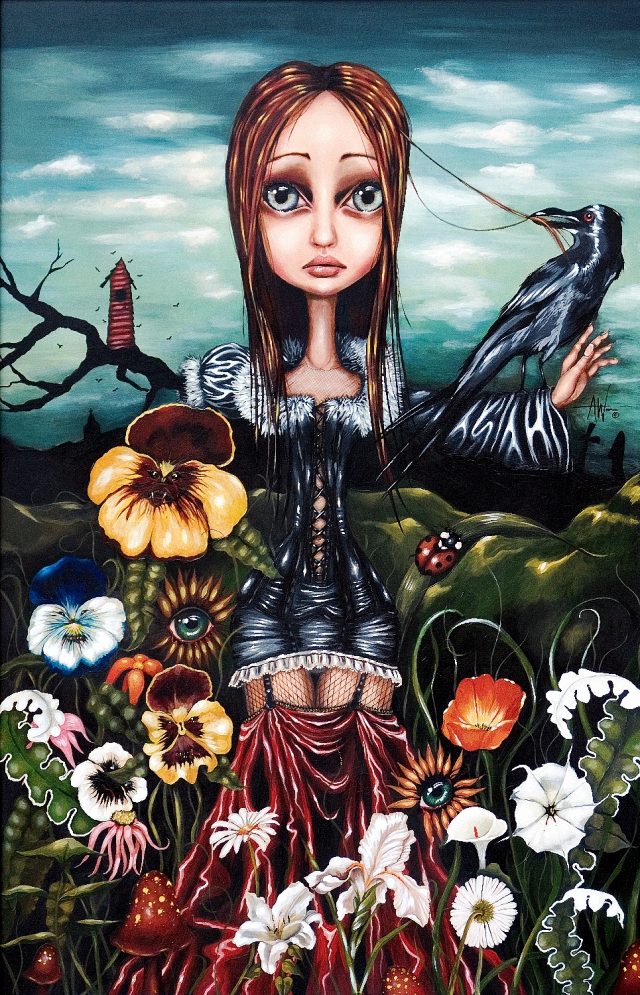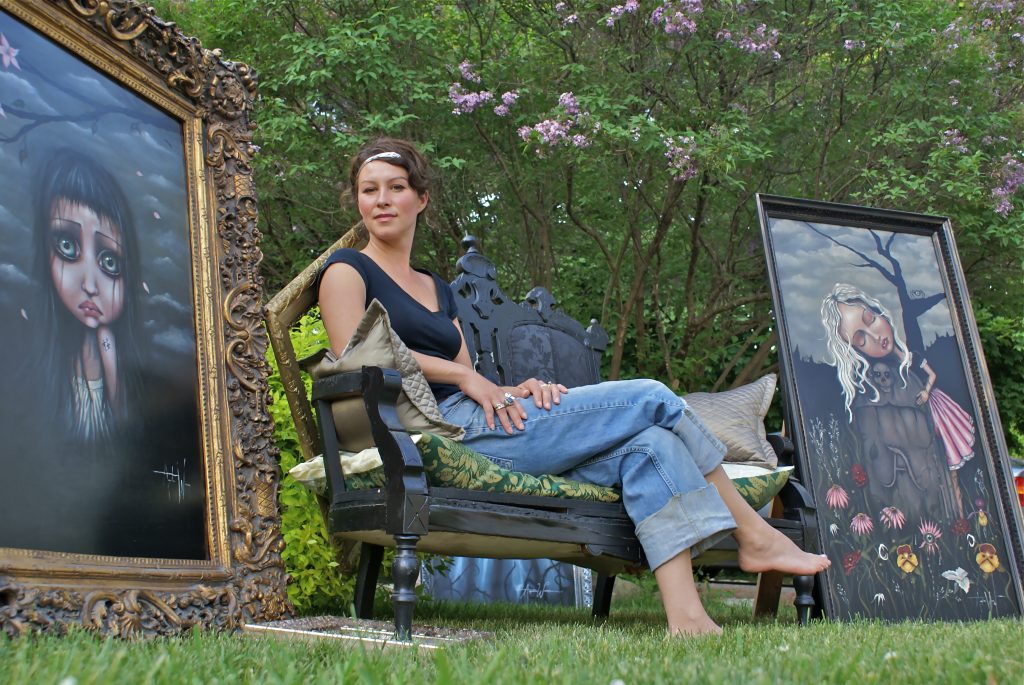
Canadian painter, Angelina Wrona, is synonymous with the mainstream emergence of pop-surrealism in Canada…
Since breaking onto the scene in 2006, her paintings have poured into gallery showrooms across the country, where they have quietly and infectiously enchanted passers by. Her painting style and technique possess an indefinable affectation that compels people, draws them in, leaving most with more questions than answers. Yet, her work is in demand world-wide.
Each painting tells a story, has a finely tuned effervescent quality, like looking into Galadriel’s pool, the story is unique and personal to the observer, and threatens to conjure images from ones past. For those who prefer to stick to the top layers of meaning, as art, her work is characterized by it’s distinct lack of definable tradition, yet falls heroically within the realm of pop-surrealist art.
Popularized by artists like Ed Roth, Mark Ryden, and Robert Williams – founder of the arts and culture magazine, Juxtapoz, pop-surrealism has a tendency to defy the very thing that art critics and scholars strive to do: to define form, to apply rules of execution; it is , in part, that very thing – a lack of definition – which seems to characterize the art form itself.
pop-surrealism is a form of organic document that speaks to cultural perspectives; is representative of how we see and interpret the world, and our collective psychological condition.
With a dedicated following in California & the opening of Kirsten Anderson’s Roq La Rue Gallery, in Seattle, Washington, the pop-surrealist movement started gaining ground in the late 1990’s. Associations were made with modern forms like conceptual, or traditional, and also marginalized disciplines like Dadaism, Abstract, and Impressionism. Treading deeper into the historical record, a thread of influence can even be made looking to 14th century artist, Hieronymus Bosch, who stepped away from medieval tradition using elaborate, surreal imagery to illustrate religious and moral themes. Anderson agrees that, in fact, there are parameters that do somewhat define pop-surrealism: it’s technically masterful, it’s contemporary and iconographic, it’s archetypal; it comes from the subconscious realm, and there is a reason behind the painting.

Of her own work, Angelina says she has seen it evolve over the last three years, after breaking onto the market. “My technique has become more refined, much of it from being comfortable with my own style and interpretation
to begin with. It’s interesting to see how the process unfolds. When I start to sketch a new idea and revise the early painting to include different elements, the depth starts to show through, and the expressions and ideas in the background come alive. It’s really about the detail.”
A registered nurse specializing in geriatric Alzheimer’ before she became a recognized artist, Angelina says there was, fortunately, never a starving artist phase. “I never did completely pull the pin on my day job to try to build a career as a painter. I worked part-time as a nurse during the evening, and it didn’t interfere with my painting.”

As for some, Angelina’s success didn’t come in a striking epiphany. She had been selling work slowly overtime. She says she realized then that she would have some measure of success. But it was during a showing at a local gallery, when a collector from Australia purchased four of her early works, that she began to realize her gift. “When I first started I was painting for me.
A few people who had seen my work commented on it and enjoyed it. A local restaurant owner wanted me to sell some paintings in her restaurant. She had several local artists hanging and never took any commission. I was actually quite nervous about it. It’s a big step the first time any artist offers their creations up for criticism. The biggest struggle is to get that confidence and keep it,” Wrona reflects. “Once, at a signing I was doing, an older woman came in and cast a very dour eye on my work. I asked her if she liked what she saw and she, not knowing I was the artist, informed me that she would only give a painting like that to someone she hated… I informed her that I was the artist and she nearly died of embarrassment. It was a good feeling to not allow the criticism to affect me in a negative way.” “My first real show was at Thinkspace Gallery, in Los Angeles.

Each painting tells a story, has a finely tuned effervescent quality, likelooking into Galadriel’s pool, the story is unique and personal to the observer, and threatens to conjure images from ones past.
Considering pieces like Never Look Back, Madame Nature, and Psst, her imagery, irrefutably, does more than just hang on a wall. Something about traditional painting of the 18th and 19th centuries – and even before that generally held true, was that it was seen not only as decorative, but was a means to record history, for posterity. Many modern art forms, pop-surrealism included, seems more a form of organic document that speaks to cultural perspectives; is representative of how we see and interpret the world, and our collective psychological condition.
“I’m a big believer that art will grab people, regardless of cultural mores,” says Angelina. “Psst… was an idea relating to the amount of damage and hurt that could be caused by gossip and jealousy.

As with the fleeting nature of the subconscious, when she is struck with an idea, Angelina says she will put what she’s doing on hold and start to sketch it out. “’Peculiar’ seems to fit much of what I do, considering the time portals, dominatrix’ in flowers, and girls wearing rabbits. I guess it depends on your point of view. There should always be something off-center to grab someone’s attention and make them think.”
There continues to be a strong demand for Angelina’s original work, with requests for custom orders coming in on a weekly basis. “There is a very strong demand. I currently have only one original for sale, ‘Resurrection’. There are some ideas I would consider doing, but when you are working with someone else’s notion you lose creative control of your work; if you don’t feel the connection with your work, it will suffer.”
On Angelina’s behalf, Gonzo Magazine would like to send a shout out to the The Children’s Hospital of Eastern Ontario, the amazing staff, and the way they value and care for their patients.








One of my favorites. 🙂